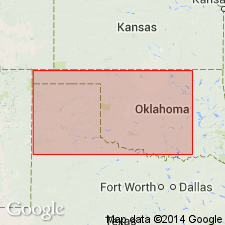
- Usage in publication:
-
- Mangum dolomite member*
- Modifications:
-
- Named
- Dominant lithology:
-
- Dolomite
- Limestone
- Shale
- AAPG geologic province:
-
- Anadarko basin
- South Oklahoma folded belt
Summary:
Named from Mangum, Greer Co, OK. No type locality designated. Occurs in Roger Mills and Greer Co, south-central OK, in Anadarko basin and South Oklahoma folded belt province. Is the top member of Greer formation. Consists of 20 ft of red clay shale topped with a 3-ft-bed of dolomitic limestone. In places it is dolomite. Character of the rock varies. Overlies Collingsworth gypsum member; underlies Quartermaster formation. Geologic map. Columnar sections. Age is Permian.
Source: GNU records (USGS DDS-6; Denver GNULEX).
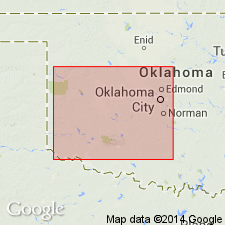
- Usage in publication:
-
- Mangum dolomite member†
- Modifications:
-
- Abandoned
Summary:
Mangum dolomite member of Greer formation presumably abandoned, because Greer formation is abandoned in this report. For the so-called "eastern area" of the Greer, the name Cloud Chief formation is proposed. It is shown that the rocks in the "western area" of the Greer belong to Blaine, Dog Creek, Whitehorse, and Cloud Chief (new) [Chaney, Kaiser, Haystack, Cedartop, Collingsworth, and Mangum, formerly members of the Greer, are presumably also abandoned.] The report area--southwestern OK--includes all or parts of 10 counties east, northeast, north, northwest and west of the Wichita Mountains, S. Oklahoma folded belt province and Anadarko basin. The new classification of the Permian of this area is as follows (ascending): Duncan sandstone (new), Chickasha formation (new), Blaine gypsum (revised), Dog Creek shale (rank raised), Whitehorse sandstone (rank raised), Day Creek dolomite (rank raised), Cloud Chief formation (new), and Quartermaster formation (revised). All of these units are stratigraphic equivalents of the Double Mountain, the uppermost Permian division of TX. Geologic map. Of Permian age.
Source: GNU records (USGS DDS-6; Denver GNULEX).
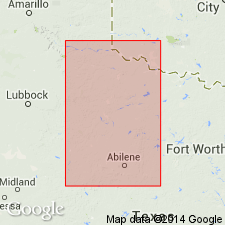
- Usage in publication:
-
- Mangum dolomite
- Modifications:
-
- Areal extent
- AAPG geologic province:
-
- Palo Duro basin
- Permian basin
- South Oklahoma folded belt
Summary:
Pl. 9. Mangum dolomite lies 64 feet below Acme dolomite, and in midst of Blaine formation of western Texas. [Age is Permian.]
Source: US geologic names lexicon (USGS Bull. 896, p. 1278).
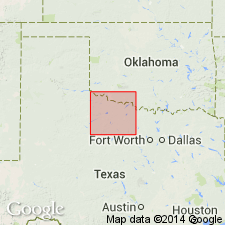
- Usage in publication:
-
- Mangum Dolomite
- Modifications:
-
- Overview
- Age modified
- Areal extent
- AAPG geologic province:
-
- Palo Duro basin
- Permian basin
Summary:
Mangum Dolomite is shown as [unranked] unit of the Blaine Formation, topmost formation of Pease River Group of Guadalupe Series (Permian) [this is an age modification--units of Pease River Group previously assigned to Leonard Series]. Blaine includes following [unranked] units: unnamed dolomite beds, Mangum Dolomite, Acme Dolomite, and Guthrie Dolomite (all separately mapped). Mangum, Acme, and Guthrie consist of units 2 to 8 ft thick, white, tan, and yellow, argillaceous, fine- to coarse-grained, thin- to medium-bedded, ripple-marked, desiccation-cracked; molds of pelecypods and large ammonoids and nautiloids locally abundant in coarse-grained beds. The unnamed dolomite beds are white, tan, and yellow, argillaceous, fine-grained, thin- to medium-bedded in units 1 to 3 ft thick, ripple-marked, desiccation-cracked; locally contains pelecypod and cephalopod molds. Locally, in Foard and Hardeman Cos, Blaine Formation pervasively faulted and locally folded owing to gypsum and salt? dissolution (karst), preventing accurate tracing of dolomite beds. Areas of relatively pronounced gypsum karst are mapped. Most dolomite beds within karst areas are mapped but mainly unnamed. Upper part of Blaine does not crop out in map area; dolomites mapped as single lines in King and Knox Cos (Permian basin) and Foard and Hardeman Cos (Palo Duro basin), north-central TX. Geologic map. Permian (Guadalupian) age.
Source: GNU records (USGS DDS-6; Denver GNULEX).
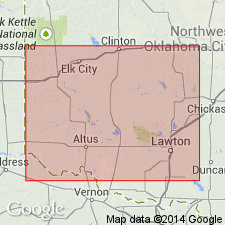
- Usage in publication:
-
- Mangum Dolomite Bed
- Modifications:
-
- Revised
- AAPG geologic province:
-
- Palo Duro basin
- South Oklahoma folded belt
Summary:
Considered to be the most significant bed in the Blaine Formation. Is widespread, typically 2-4 ft thick, caps major buttes and cuestas. Is a key bed that separates Blaine into members. Overlies the Elm Fork Member (first used), lower member of Blaine. Forms the basal bed of unit 1 of the Van Vacter Member (revised) of the Blaine Formation of El Reno Group. Lies at base of unit 1 of the Van Vacter. Ranges from 1 to 7.5 ft thick. Cross sections. Measured sections. Consists of gray, very fine crystalline, oolitic dolomite. Sections measured in Harmon and Jackson Cos (Palo Duro basin) and Greer Co (S. Oklahoma folded belt province). Permian age.
Source: GNU records (USGS DDS-6; Denver GNULEX).
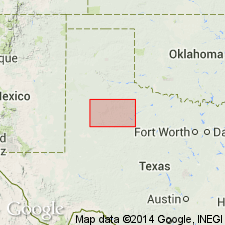
- Usage in publication:
-
- Mangum Dolomite
- Modifications:
-
- Mapped 1:250k
- Dominant lithology:
-
- Dolomite
- AAPG geologic province:
-
- Palo Duro basin
- Permian basin
Summary:
Mangum Dolomite [unranked] in lower part of Blaine Formation. Separately mapped in Cottle, Foard, King, and Stonewall Counties, Texas. Age is Permian.
Source: Publication.
For more information, please contact Nancy Stamm, Geologic Names Committee Secretary.
Asterisk (*) indicates published by U.S. Geological Survey authors.
"No current usage" (†) implies that a name has been abandoned or has fallen into disuse. Former usage and, if known, replacement name given in parentheses ( ).
Slash (/) indicates name conflicts with nomenclatural guidelines (CSN, 1933; ACSN, 1961, 1970; NACSN, 1983, 2005, 2021). May be explained within brackets ([ ]).

